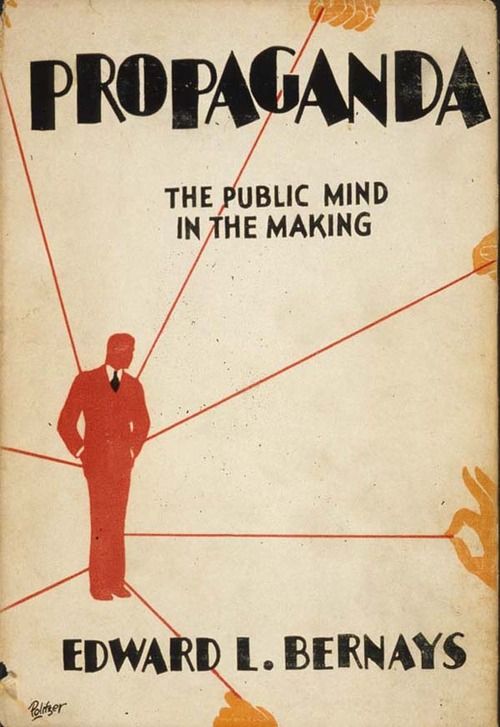
By: Randy Engel
Part I: The Dangers of Government Falsehoods: Background on Government Propaganda Machines
Introduction
The danger of government lies, and the implications of official deception of whole peoples and nations, could not be more relevant than it is today when our God given natural rights and our Constitutional freedoms are systematically being ground into the dust under the guise of protecting the “public health” from Covid-19.
In his 1928 classic Propaganda, Sigmund Freud’s nephew, Edward L. Bernays [1] explains approvingly of how governments, powerful corporations, and foundations are capable of manipulating and regimenting the public mind in all areas of life including war, politics, business, education, and medical science.
According to Professor Mark Crispin Miller,[2] who wrote a new introduction to the Bernays masterpiece in 2004:
“Bernays (1891-1995) pioneered the scientific techniques of shaping and manipulating public opinion, which is called ‘engineering of consent.’ During World War I, he was an integral part – along with Walter Lippmann – of the U.S. Committee on Public Information (CPI), a powerful propaganda machine that advertised and sold the war to the American people as one that would ‘Make the World Safe for Democracy.’ The marketing strategies for all future wars would be based on the CPI model.”[3]
The Existence of an Invisible Government
Writing in the 1920s, Bernays, an Austrian-American Jew, “the father of public relations,” gleefully acknowledged the reality of “invisible governors,” who rule the world and bring organization out of chaos to society:[4]
The conscious and intelligent manipulation of the organized habits and opinions of the masses is an important element in democratic society. Those who manipulate this unseen mechanism of society constitute an invisible government which is the true ruling power of our country.
We are governed, our minds molded, our tastes formed, our ideas suggested, largely by men we have never heard of. This is a logical result of the way in which our democratic society is organized. …
Our invisible governors are, in many cases, unaware of the identity of their fellow members in the inner cabinet.
They govern us by their qualities of natural leadership. Their ability to supply needed ideas, and by their key position in the social structure. …[5]
Of course, the most important factor Bernays initially leaves out is MONEY. After all, today’s contenders for domination in the New World Order – like Bill Gates or George Soros or Mark Zuckerberg – would be just another Tom, Dick, or Harry without their billions.
Later, however, Bernays does admit that “the invisible government tends to be concentrated in the hands of the few because of the expense of manipulating the social machinery which controls the opinions and habits of the masses.”[6]
WWI Created New Propaganda Techniques
Bernays claims that:
It was, of course, the astounding success of propaganda during the war that opened the eyes of the intelligent few in all departments of life to the possibilities of regimenting the public mind. The American government and numerous patriotic agencies developed a technique which, to most persons accustomed to bidding for public acceptance, was new. They not only appealed to the individual by means of every approach – visual, graphic, and auditory – to support the national endeavor, but they also secured the cooperation of the key men in every group – persons whose mere word carried authority to hundreds or thousands or hundreds of thousands of followers. They thus automatically gained the support of fraternal, religious, commercial, patriotic, social, and local groups whose members took their opinions from their accustomed leaders and spokesmen, or from the periodical publications which they were accustomed to read and believe. At the same time, the manipulators of patriotic opinion made use of the mental clichés and the emotional habits of the public to produce mass reactions against the alleged atrocities, the terror, and the tyranny of the enemy. IT WAS ONLY NATURAL, AFTER THE WAR ENDED, THAT INTELLIGENT PERSONS SHOULD ASK THEMSELVES WHETHER IT WAS POSSIBLE TO APPLY A SIMILAR TECHNIQUE TO THE PROBLEMS OF PEACE (emphasis added).[7]
Interestingly, Bernays states that the new dictatorship is not limited to government matters but embraces dictators in all fields of life including that of fashion. For example, he notes that Paris fashion leaders set the mode of the short skirt [worn by bob-haired flappers] for which, twenty years before, any woman would have simply been arrested and thrown into jail by the New York City police, and the entire women’s clothing industry, capitalized at hundreds of millions of dollars, must be reorganized to conform to their dictum.[8]
In his chapter, “The Psychology of Public Relations,” Bernays asks, “If we understand the mechanism and motives of the group mind, is it not possible to control and regiment the masses according to our will without their knowing about it?”[9]
Within certain limits and up to a certain point, Bernays answers in the affirmative.
Citing the earlier studies of Wilfred Trotter and Gustave Le Bon on group psychology, which established that the “collective mind” differs from the “individual mind” or “consciousness,” Bernays affirms that “the group mind does not think in the strict sense of the word. In place of thoughts, it has impulses, habits, and emotions. In making up its mind, its first impulse is usually to follow the example of a trusted leader.”[10]
“But when the example of the leader is not at hand and the herd must think for itself, it does so by means of clichés, pat words, or images which stand for a whole group of ideas and experiences,” says Bernays.[11] “By playing upon an old cliché, or manipulating a new one, the propagandist can sometimes swing a whole mass of group emotions,” he says, adding that, “Usually, the individual mind will succumb to the will of the crowd.”[12]
Before Bernays moves on to explain how propaganda functions in specific departments of group activity including business, politics, education, social work, and the media, he states:
I have tried to explain the place of propaganda in modern American life and something of the methods by which it operates – to tell the why, the what, the who and the how of the invisible government which dictates our thoughts, directs our feelings, and controls our actions.
A Different View of Government Propaganda
In war, Truth is the first casualty[13]
In 1928, the same year Bernays’ Propaganda was published, pacifist British MP, Arthur Ponsonby, issued his anti-propaganda classic Falsehood in War Time – Containing An Assortment of Lies Circulated Throughout The Nations During the Great War.[14] The modest-size book, available as a free PDF online, highlights major lies that were inflicted upon the hapless wartime civilian populations of the Allied Forces (Russia, France, Britain, and the United States) against the Central Powers (Germany, Austria-Hungary, Turkey, and Bulgaria) during the First World War.
Ponsonby acknowledges in his introduction that falsehood is a recognized and extremely useful weapon in warfare, and every country used it quite deliberately including the Allied Forces and the Central Powers 1) to deceive its own people, 2) to attract neutrals 3) and to mislead the enemy. [15]
According to Ponsonby:
The ignorant and innocent masses in each country are unaware at the time that they are being misled, and when it is all over, only here and there are the falsehoods discovered and exposed. As it is all past history, and the desired effect has been produced by the stories and statements, no one troubles to investigate the facts and establish the truth.[16]
Ponsonby, however, does take the trouble to enumerate a number of British, French, American, and other Allied and Central Powers official wartime falsehoods including a number of atrocity fabrications like:
- The Belgian Baby Without Hands – That German soldiers were cutting off the hands of babies and children (and eating the parts), and impaling them on bayonets; and violating Belgium nuns, were popular themes of Allied propaganda.[17] When the reports were questioned by British members of Parliament, (and in the case of the violation of Catholic nuns investigated by the Vatican), no evidence was ever produced to support the charges against “the Huns.”
- The Crucifixion of a Canadian (or an American or a young naked girl) sometimes on a barn door – These reports were backed up by fellow soldiers even though there were no eyewitnesses. In the case of the Canadian officer said to be crucified near the Belgium town of Ypres, U.S. Army Commander General Peyton C. March later denied the story. However, on April 12, 1919, the U.S. magazine, Nation, published a letter from Royal West Kent Private E. Loader, who declared he had witnessed the crucifixion of the Canadian soldier. The letter was subsequently repudiated by Captain E. N. Bennett who wrote to the Nation, informing its editors that there was no such private on the rolls of the Royal West Kents, and that the 2nd Battalion was in India during the entire war.[18]
- The Corpse Factory – On April 16, 1917, the British Times reported that Germany was chemically treating the dead bodies of its soldiers (and enemy soldiers) to 1) distill glycerin for the manufacture of munitions, 2) to provide fat for lubricating oils 3) and was grinding human bones into powder for mixing with pigs’ food and making fertilizer.[19]
To make sure the lie gained world-wide traction, the Crown and Parliament, both of which were well aware that the propaganda reports were ludicrous and absolutely false, remained silent, even when informed that the “Corpse Factories” were, in fact, factories for the disposal of dead carcasses of horses and other animals found on the battlefield.[20]
It was not until December of 1925 that the truth of the matter was finally admitted by Sir Austen Chamberlain KG[21], the half-brother of Prime Minister Neville Chamberlain, who put the final nail in the propaganda coffin when he bluntly stated, “there was never any foundation for it [the rumour].”[22]
The Sinking of the Lusitania
Ponsonby’s report on the tragic sinking of the RMS Lusitania, a British ocean liner on route from New York City to Liverpool, England on May7, 1915, is especially instructive since the event provided “the necessary lever at last to bring America into the war.”[23] Americans were told that a German U-boat had torpedoed a defenseless passenger ship flying the American flag and bearing only civilian passengers and an ordinary cargo.
Unfortunately, the “ordinary cargo,” consisted of thousands of cases of small arms ammunition, shrapnel shells, and brass percussion fuses weighing about 173 tons. The ship, which had been secretly financed by the British Admiralty and fitted for military service including gun mounts installed on her decks,[24] sank in a record 18 minutes killing 1,198 passengers and crew including 124 Americans.
Had the Lusitania only carried “ordinary cargo,” it is estimated that time and circumstances would have permitted many of these victims to have survived and reach the Irish shore at Kinsale, instead of being blown to bits by the second ammunition explosion.[25]
However, the British and American propaganda Lusitania campaign that followed ensured that all the blame fell upon Germany, and on April 6, 1917, the United States declared war on Germany.
The reader will note that when Progressivist U.S. Senator Robert “Fighting Bob” La Follette (1906-1925) stated that the Lusitania carried munitions, he was threatened with expulsion from the U.S. Senate. The threat was withdrawn when Mr. Dudley Field Malone, collector at the port of NYC, confirmed that the ship carried a large munition cargo consigned to the British Government, saying he would testify in favor of Senator La Follette.[26] However, the Wilson administration refused to permit the publication of the facts.[27]
U.S. Government Opens Propaganda Office
As noted earlier, the U.S. Committee on Public Information (CPI) patterned itself after the British Crewe House propaganda machine headed by Alfred C.W. Harmsworth, later Alfred Lord Northcliffe, a British journalist and legendary newspaper magnate.[28]
The CPI, also known as the Creel Committee, named after its chairman, journalist George Creel, was the United States Government’s first official Office of Wartime Propaganda Machine.
“The frenzy with which the whole propaganda was conducted in America surpassed anything we experienced here [Britain],” Ponsonby says.[29]
Some atrocity fabrications, like the Germans giving poisoned candy to children to eat and live hand-grenades to play with, were so outrageous that General John Pershing, General of the Armies, who served as Commander of the American Expeditionary Forces on the Western Front during the Great War, issued a cablegram that instructed the U.S. War Department to publicly disavow these stories which had no basis in fact.[30]
Similarly, Admiral William S. Sims, Commander of all U.S. Naval Forces in Europe, repudiated hideous U.S. news stories and movies promoted by the CPI against German submarine commanders. In a statement published by the New York Tribune in April 1923, Sims stated that “There exists no authentic report of cruelties ever having been committed by the commander or the crew of a German submarine. The Press reports about cruelties were only meant for propaganda purposes.”[31]
WWI War Ends, But Government Propaganda Machine Continues
Unfortunately, as Bernays points out, why should Government kill a good thing for itself?
And Ponsonby prophetically states, “… of course, we know that such clever propagandists are equally clever in dealing with us after the event as in dealing with the enemy at the time.”[32]
The CPI’s successor in WWII was the Office of War Information (OWI) promulgated by Executive Order 9182 under the Franklin D. Roosevelt Administration on June 13, 1942. The various propaganda departments of the OWI included the Foreign Information Service, Bureau of Intelligence, Psychological Warfare Branch, Book and Magazine Bureau, Extensive Surveys Division, Bureau of Public Inquiries, Bureau of Motion Pictures, and the Propaganda Intelligence Section, etc.[33]
The OWI was officially terminated on September 15, 1945, but was succeeded through the years till the present day by a litany of federal propaganda departments including the United States Information Service, the Office of Strategic Services, and the Central Intelligence Agency.[34]
Ponsonby’s final observations that:
War is fought in this fog of falsehood, a great deal of it undiscovered and accepted as truth. The fog arises from fear and is fed by panic (bold added). Any attempt to doubt or deny even the most fantastic story has to be condemned at once as unpatriotic, if not traitorous. This allows a free field for the rapid spread of lies.[35]
In wartime, failure to lie is negligence, the doubting of a lie a misdemeanor, the declaration of the truth a crime (bold added).[36]
In future wars we have now to look forward to a new and far more efficient instrument of propaganda – the Government control of broadcasting. Whereas, therefore, in the past we have used the word “broadcast” symbolically as meaning the efforts of the Press and individual reporters, in the future, we must use the word literally, since falsehood can now be circulated UNIVERSALLY, SCIENTIFICALLY, AND AUTHORITATIVELY (caps and bold added).[37]
There are some who object to war because of immorality, there are some who shrink from the arbitrament of arms because of its increased cruelty and barbarity; there are a growing number who protest this method, at the outset known to be unsuccessful, of attempting to settle international disputes because of its imbecility and futility. But there is not a living soul in any country who does not deeply resent having his passions roused, his indignation inflamed, his patriotism exploited, and his highest ideals desecrated by CONCEALMENT, SUBTERFUGE, FRAUD, FALSEHOOD, TRICKERY, AND DELIBERATE LYING ON THE PART OF THOSE IN WHOM HE IS TAUGHT TO REPOSE CONFIDENCE AND TO WHOM HE IS ENJOINED TO PAY RESPECT (caps and bold added).[38]
The Current Battle for Our Humanity
I don’t think the reader can find a better description of the current Government debacle surrounding the Coronavirus (Covid-19) “pandemic” than Ponsonby’s warning made almost 100 years ago.
The nature of the current war in America and the world, being orchestrated by the reigning Technological and Pharmaceutical Oligarchies of the so-called New World Order is much different than previous wars we have fought. And the implications of failing to defeat the enemy are much greater because we are fighting the ultimate battle for God, family, and nation.
Indeed, what is at stake is what it means to be HUMAN!
(To be Continued)
[1] Edward Bernays, Propaganda, Horace Liveright Publishing, NY., 1928. Original copy available online at https://archive.org/details/BernaysPropaganda/mode/2up.
[2] Mark Crispin Miller is Professor of Media, Culture and Communication at New York University. See https://markcrispinmiller.com. The 2004 edition of Propaganda with Miller’s introduction, which this writer used, is available at Amazon.com. As Miller notes, “Propaganda mainly tells us that Bernays’ true métier [job or occupation] was to help giant players with their various sales and image problems.”
[3] Bernays, Propaganda, commentary by Miller on back cover
[4] Ibid., p. 17.
[5] Ibid., p. 37.
[6] Ibid., p. 63.
[7] Ibid., p. 54-55.
[8] Ibid., p..61.
[9] Ibid., p. 71.
[10] Ibid., p. 73.
[11] Ibid., p. 74.
[12] Ibid.
[13] See In war, truth is the first casualty. – Quote (yourdictionary.com).
[14] PDF available at Falsehood In Wartime (World War 1) : Arthur Ponsonby : Free Download, Borrow, and Streaming : Internet Archive. This article uses the 1928 E.P. Dutton & Co., Inc., New York edition.
[15] Ibid., p.13
[16] Ibid.
[17] Ibid., pp. 78-82
[18] Ibid., pp. 91-93.
[19] Ibid., pp. 102-113.
[20] Ibid., p. 105.
[21] The oldest British Order of Chivalry
[22] Ibid., pp.111-112.
[23] Ibid., pp. 121-125.
[24] See Remember the Lusitania: 3 pieces of World War I propaganda | National Museum of American History.
[25] Ponsonby, pp. 102-113.
[26] Ibid., pp. 122-123.
[27] Ibid., p. 122.
[28] See Secrets of Crewe House – Wikisource, the free online library.
[29] Ponsonby, p. 183
[30] Ibid., p.183
[31] Ibid., p. 185
[32] Ibid., p.17.
[33] See United States Office of War Information – Wikipedia.
[34] Ibid.
[35] Ponsonby, p.25-26.
[36] Ibid., p.27.
[37] Ibid., pp. 27-28.
[38] Ibid., p. 29.

